Microsoft BUILD: Windows 8, A Pre-Beta Preview
by Brian Klug & Ryan Smith on September 13, 2011 12:05 PM EST- Posted in
- BUILD
- Windows
- Microsoft
- Windows 8
- Trade Shows
Mobile Experience Side
Coming from the smartphone side of things, I really see many shades of WP7 inside Windows 8. That’s actually dramatically understating the state of things - the core of what we’ve been shown of Windows 8 that’s new literally is either adopted from or directly analogous to much of WP7.
It doesn’t come as a surprise to me at all that the desktop Windows experience is moving in this direction, (and it seems as though the Xbox 360 interface will follow shortly). The positive result is that Windows 8’s touch experience feels much closer to the ground-up approach Android Honeycomb or iOS have taken than the than the “Tablet-Edition” versions of Windows XP and the tablet integration in Vista and 7. I used a UMPC and remember Origami and how that application lived as its own standalone mode of operation as an application within windows. What Windows 8 is the inverse - Windows now lives inside a Metro-themed Start screen that looks like WP7 for the desktop. Or at least it does in this demo we’ve been shown currently.
The tablet experience is now absolutely on par with modern mobile OSes - sure there are a few more things that need to be included, but the foundation is there for Windows to suddenly become more than an OS that also can do touch-based interaction.
IE 10
Microsoft has been actively promoting IE 10 since MIX 11, with two platform previews so far, and IE 10 is an integral part of Windows 8 both as a browser and as a runtime for HTML based Metro applications. We won’t go into exacting detail about what’s new and interesting inside IE10, beyond mentioning that it improves upon IE 9’s GPU acceleration and improves web compliance support including CSS3. What’s relevant in Windows 8 is that IE 10 gets two views - one belonging to the Metro-heavy start menu experience, which we’ll call the mobile view, and the other belonging to the traditional desktop windows view.
This dichotomy exists between the two IE10 experiences, which is in itself a bit curious. The mobile view is almost exactly what IE looks like inside Windows Phone 7.5 - at the bottom is the URL bar and controls, and with a slide down gesture, at the top are tabs. Meanwhile the IE10 desktop experience uses the older IE 9 UI. At this point, it doesn’t appear that windows opened in one are transportable to the other.
The mobile view is almost exactly like WP7.5’s however, the URL bar disappears when scrolling, and the browser supports a completely fluid multitouch experience that feels speedy.
Cloud
Windows 8 offers considerable integration with Windows Live and SkyDrive. Local user accounts can be directly tied to a Live account on trusted PCs, and then be used for live roaming. Live roaming enables each connected device to access the same set of accounts for photos, email, calendar, and contacts and speed up initial setup. For example, photos captured on a WP7.5 device’s camera roll can be immediately visible on a Windows 8 PC authenticated against the same Live account. This is very close to how camera roll will integrate into Apple’s iCloud and synchronize across iOS and OS X Lion.
One thing is clear, and it’s that Microsoft plans to heavily integrate and leverage its Live services into Windows 8 and provide an ecosystem-wide way to migrate accounts settings, photos, and data between mobile, tablet, and desktop.
Samsung’s Reference Tablet
We’ve been loaned Samsung tablets running the Windows 8 Evaluation copy used for this article, and thought it bears going over since the device will no doubt become a reference platform for Windows 8 development. This hardware is also being given away to developers in attendance at BUILD as well.
The Samsung tablet is none other than the 700T model announced at IFA very recently, and it packs a relatively impressive spec list.
| Samsung 700T Windows 8 Development Notebook/Slate - Specifications | |
| Processor |
Intel Core i5-2467M (2x1.6GHz + HT, 32nm, 3MB L3, 2.3GHz Turbo, 17W) |
| Chipset | Intel 6 series |
| Memory | 4 GB DDR3 1333MHz RAM (1 SODIMM) |
| Graphics | Intel HD 3000 |
| Display | 11.6" Super PLS (1366x768) |
| Hard Drive | 64 GB Samsung SSD |
| Networking | 802.11n WiFi + Gigabit Ethernet + GSM/WCDMA HSPA+ |
| Sensors | NFC, Magenetometer, Accelerometer, GPS, ALS, Front, Rear Camera |
| Dimensions | 12.9 mm thick, 909 grams |
The 700T includes GSM/WCDMA cellular connectivity courtesy of an Option GTM661W combination cellular modem and WiFi card. The GTM661W uses a Qualcomm MDM6200 baseband, which also provides GPS. There are also sensors such as ambient light, an accelerometer, and the two cameras onboard.
In addition, the 700T includes an active digitizer and capacitive touch display, making it suited for all three interaction modes that Windows 8 will support. The device comes with a dock that doubles as a charging stand, and also replicates full size HDMI, GigE, and a USB 2.0 port on the back. The slate has one USB 2.0 port, a headphone jack, microSD card slot, SIM slot, and a rotation lock button.
Samsung calls the 700T a slate, we've elected to call it a tablet, and the device feels decent if not a bit heavy in the hands. The 700T is also the first 16:9 tablet we've seen, with Android adopting 16:10 and iOS going with 4:3, which makes portrait a bit extreme.


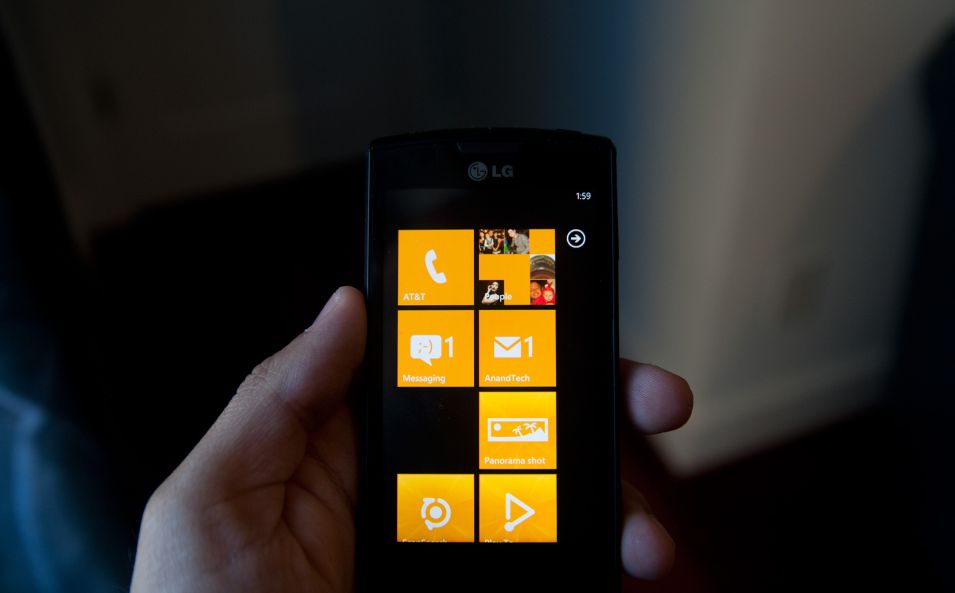
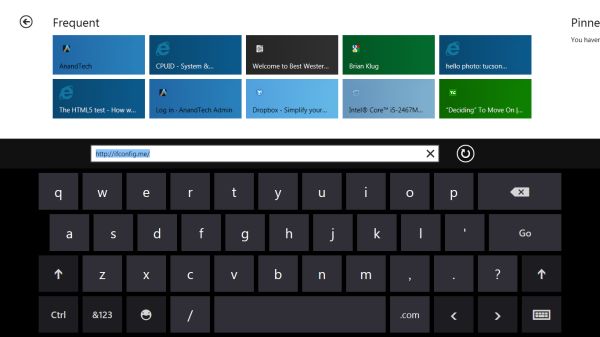
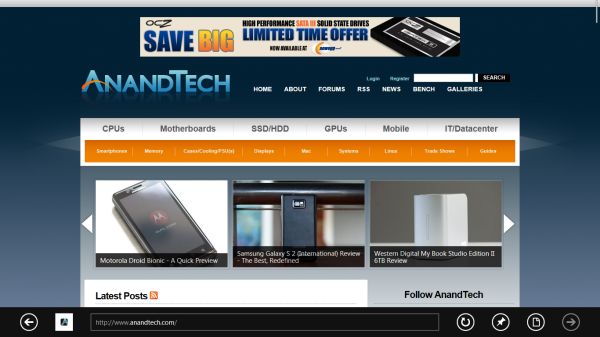
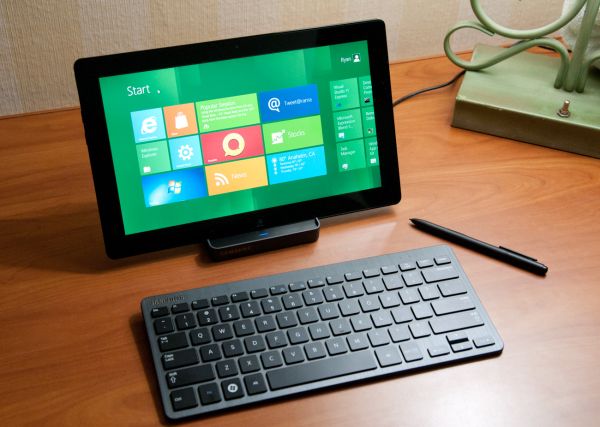
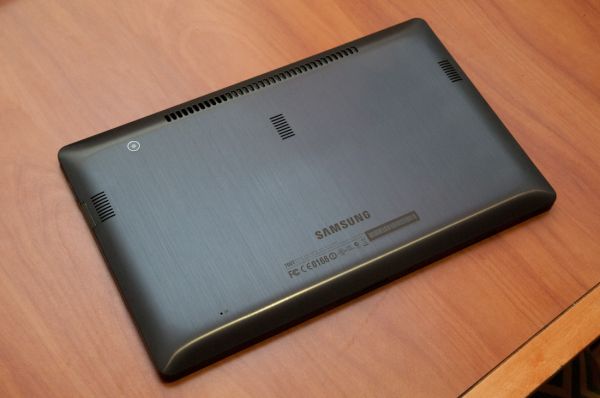
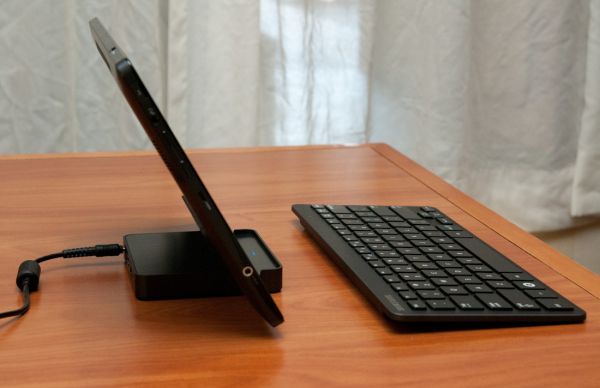








235 Comments
View All Comments
dagamer34 - Tuesday, September 13, 2011 - link
If you don't like the Metro UI, no one is forcing you to use it.jeremyshaw - Tuesday, September 13, 2011 - link
yeah, seriously. MS isn't making Metro UI for desktops, just tablets and users who want it...futurepastnow - Tuesday, September 13, 2011 - link
Yes, they are. The Explorer shell is gone and Metro has replaced it completely. In these early builds, at least, Metro cannot be turned off and you cannot boot to the desktop.dragonsqrrl - Tuesday, September 13, 2011 - link
Yes, in these early builds that may be the case, but Microsoft has stated publicly on multiple occasions that the metro UI will be optional on desktops. You can use it in combo with the traditional explorer interface (similar to the demo), or disable it entirely.UMADBRO - Tuesday, September 13, 2011 - link
He just wants to go around crying because he might have to learn something new. I think a complete redesign like this is needed. Windows was getting rather boring, even with some of the new stuff added in 7. Give it a chance at least. Im sure for all the old fogeys that have an aneurysm at the thought of anything changing, there will be some classic options. And also on note, ITS A PRE-BETA DEVELOPER RELEASE. NOTHING IS FINAL YET! SO CALM THE F&*$ DOWN!loll123 - Wednesday, September 14, 2011 - link
And you seriously think that Windows is made primarily for people like you? The corporate customers (the ones that are Microsoft's bread and butter) who resisted upgrading from Windows XP up until this day aren't going to accept change like this just because Microsoft says it's the way forward. They are going to have backtrack and redesign just like they did with Vista -> 7, unless the board of directors decide to clean up this mess and rein the design in before final release (as seems to be business as usual at Microsoft).BioTurboNick - Thursday, September 15, 2011 - link
You seem to be suggesting that 7 was a backtrack on Vista. That is far from the case.mlambert890 - Thursday, September 15, 2011 - link
+1... in addition, corporations are refreshing more and more slowly and are more and more out of sync with consumers. This is to the extreme detriment of IT as consumerization is a real trend. IT is reaching an "adapt or die" point in time and it is almost certain the latter will happen. Eventually businesses will simply allow the 'bring your own' model and contract services to provide capability.These are well known and understood industry trends and are real to anyone who *actually* works in the industry. The only folks who don't 'get it' are IT cube workers in denial or kids posting on blogs who think they understand the industry by reading comment threads.
This is actually a big problem for Microsoft because consumers are becoming a bigger force, but they are failing against Apple to capture enthusiasm with new consumers because legacy IT people, and out dated Windows users, want to keep the product stagnating.
Lost interest on the consumer side coupled with absolute inertia on the IT side is a killer for MSFT. They have to try to do something. Maybe Metro isnt it, but the nay-sayers on this thread have zero clue and are irrelevant.
The massive success of Apple has been absolute proof that consumers want a commoditized experience and the increasing presence of macbooks and ipads (guerilla style) in even *large* enterprises is proof that business is more than happy to pass the end user technology burden *onto* users.
If someone is willing to BUY and SUPPORT their OWN MacBook and ipad, why NOT let them if you are the CFO? All you need to do is ensure that your corporate apps are all presented via browser and/or managed service and enterprises are fast moving to make that happen.
It is do or die time for MSFT. if they listen to the eternal bitching and moaning of forum malcontents, they'll end up dying.
loll123 - Friday, September 16, 2011 - link
People like you say all this while Microsoft are enjoying record sales with Windows 7 (and record profits as a company as a result), and while no one can show any numbers that tablets other than those made by Apple are actually selling. In the end, although it might take the intervention of shareholders or the BoD, I think Microsoft will know better than to throw out their existing (and extremely profitable) business for what is increasingly looking like a new IT bubble.loll123 - Friday, September 16, 2011 - link
I understand your point, but a backtrack is exactly what it was. Windows 7 took all the good stuff from Vista like UAC, aggressive disk caching and the re-designed audio kernel and put them in a system with more mature drivers, important tweaks and with a smoothness and a UI that users actually liked rather than reviled. They responded to the criticisms of Vista and the result was an excellent operating system. It's no coincidence that Windows Vista failed miserably whereas Windows 7 was a huge success, but the difference was definitely in the finer details and in the user experience. Eventually Microsoft are going to have to bow to customer pressures in the case of Windows 8 as well.